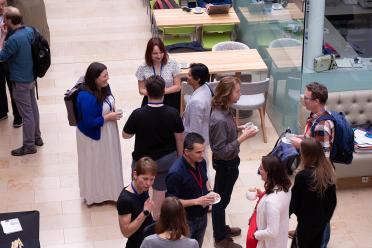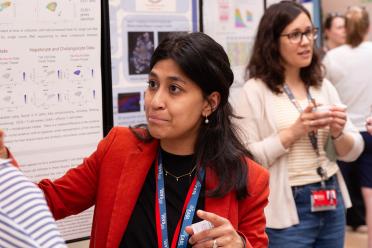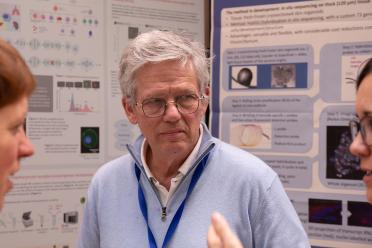Integrating single-cell and spatial genomics across the tree of life
New methods for visualising and sequencing genetic material from a single cell are allowing scientists to explore fundamental questions about living systems.
Emerging in 2009, rapid advancement in technology has driven single cell analysis forward with an astonishingly diverse array of applications including disease prevention, food security and biodiversity loss.
Last week the Earlham Institute hosted the 'Single-Cell and Spatial Symposium’, a vital opportunity to bring together scientists across different backgrounds.

Delegates networking during a coffee break, including Keynote speakers Prof Muzlifah Haniffa from Wellcome Sanger Instituyte, and Dr Tanya Foley from Institut Pasteur
The importance of collaboration cannot be understated - working across disciplines to study the vast datasets and range of applications is crucial for continued advancement across the field. The integration of single cell and spatial transcriptomics has enabled a wave of breakthroughs and greater insights into major global challenges.
Introducing the event, Dr Iain Macaulay, the Institute’s Technical Development Group Leader, explained how single cell researchers work across the tree of life.
“We apply genomics to answer complex biological questions,” he said. “The function of most biological systems is derived from the spatial organisation of cells.
“Single cell technology is continuing to advance and has become part of the mainstream, with applications across all living systems.”
Spatial Transcriptomics involves visualising expression in a cell not as an isolated unit but in relation to surrounding cells - which lets researchers explore how cells work together to form a tissue, or even a whole organism.

Dr Meha Patel, Clinical PhD Fellow in the Macaulay Group at the Earlham Institute
A vast range of single cell research field was showcased at the symposium.
Talks featured subjects as diverse as wheat grain development, brain variation in Parkinson’s disease, engineering of plant nitrate-responsive gene circuits, and the mechanics of embryonic diapause in turquoise killifish – a species with eggs which remain dormant for years until conditions are right to hatch.
Keynote speaker Professor Muzlifah Haniffa, Head of Cellular Genetics and Senior Group Leader, at the Wellcome Sanger Institute, presented her research into the human prenatal immune system.
Her fascinating studies explore the role of immune cells in skin development, investigating how macrophages and fibroblasts enhance the endothelial network, as well as why prenatal skin does not scar.
She also explained how the presence of different types of fibroblasts in healthy and diseased skin suggests the possibility that single cell analysis could achieve earlier diagnosis of the rare skin cancer cutaneous T-cell lymphoma.
Another important study into human health was led by Dr Pascal Barbry, Research Director, Institute of Molecular and Cellular Pharmacology, at the National Centre for Scientific Research (CNRS) who spoke on using single cell and spatial transcriptomics to compare function in healthy and pathological lungs, as part of the Human Lung Cell Atlas.
He explained people with chronic obstructive pulmonary disease (COPD) show differences in composition of lung tissue. Single cell sequencing technologies provide a lot of information on variation and a cell atlas of the lung would be an invaluable resource for future research.
Using the model species Zebrafish, Dr Tanya Foley, Postdoctoral Researcher in the Zebrafish Neurogenetics Group at Institut Pasteur, discussed her research on neural stem cells.
Neural stem cell populations in the vertebrate brain generate adult-born neurons for brain plasticity, growth, and repair. Single-cell transcriptomic data can be used to characterise their substates and dynamics.
And from humans to microbes - Dr Ramunas Stepanauskas, Director of the Single Cell Genomics Centre at the Bigelow Laboratory for Ocean Sciences, shared his passion for uncovering the mysteries of the marine microbiome with his work on Global Ocean Reference Genomes.
This massive research project aims to develop a genomic atlas of microbial life in the ocean, from tropical surface water to deep sea. Dr Stepanauskas described finding 2037 genomes with staggering diversity in just 300 nanolitres of seawater.
Take a look at our upcoming workshop later this year:
Following the event, Dr Macaulay said he thought the symposium had been particularly successful in bringing researchers together.
“People felt the two-day format was more relaxed and there was more time to talk and engage, which has always been a major goal for us” he said.
“The symposium has always been a space for early career researchers to present early work, and for people to present very preliminary findings. It was never intended to be a large, intimidating conference, but more a small, friendly meeting with room for discussion. And the extra day really helped give people the opportunity to talk.”

Dr Pascal Barbry, Keynote Speaker and Research Director, Institute of Molecular and Cellular Pharmacology, CNRS
Earlham Institute Group Leader Dr Wilfried Haerty was on the organising committee for the symposium. He said the two-day event was very well attended and there were some eye-opening discussions.
“There were some truly exciting talks,” he said. “It was fascinating to hear about the democratisation of these techniques. We are starting to see single cell technologies applied in hugely diverse areas. We heard about work in plants, animals, bacteria and humans.”
“A big thank you to all the sponsors of the event – thanks for helping make this possible.”
The event - held in partnership with the University of East Anglia (UEA) - was made possible by sponsors including BioLegend, 10X Genomics, Illumina, Vizgen, Pixelgen, BD Biosciences, Parse Biosciences, Singleron and Proteintech.
As well as conducting our own single cell research, the Earlham Institute supports all stages of cell analysis - from isolation and library preparation to sequencing and analysis.
Our cutting-edge technology and infrastructure, and our expertise in cell sorting and single-cell genomics, is available for you to explore - whether you are looking for collaboration, contracted research, or training opportunities.